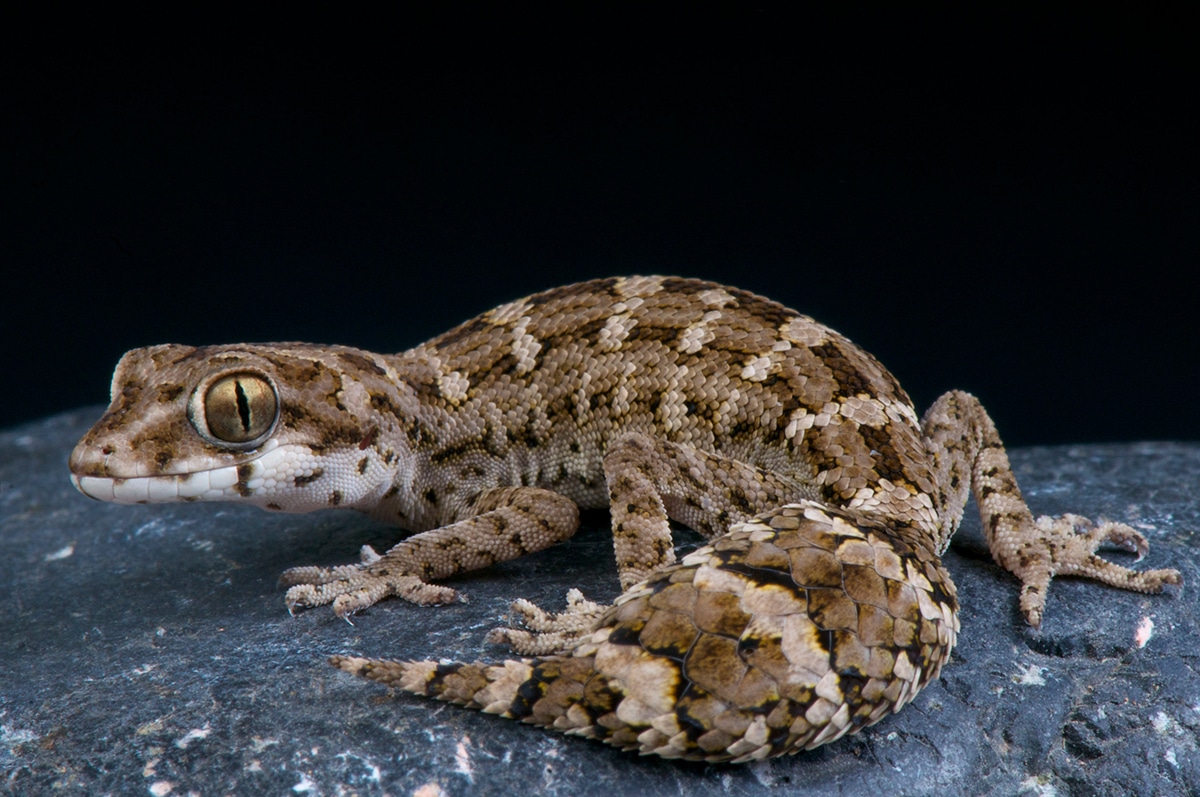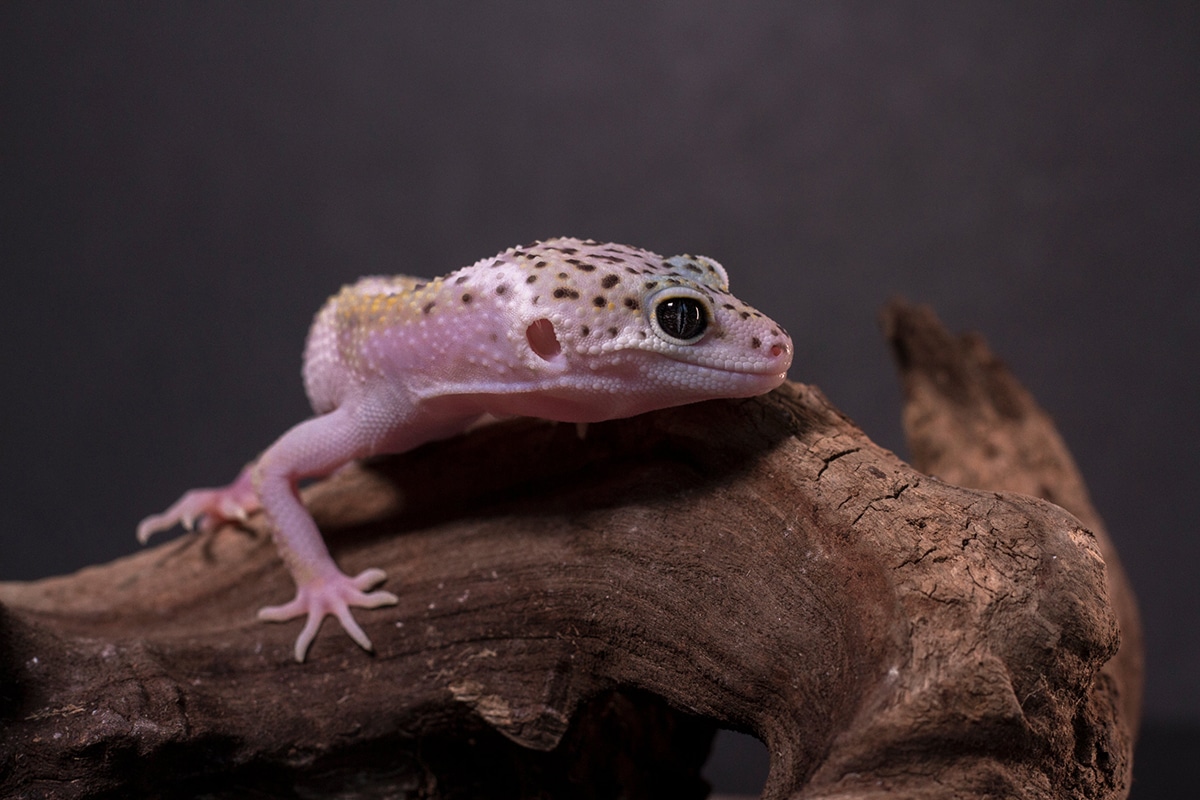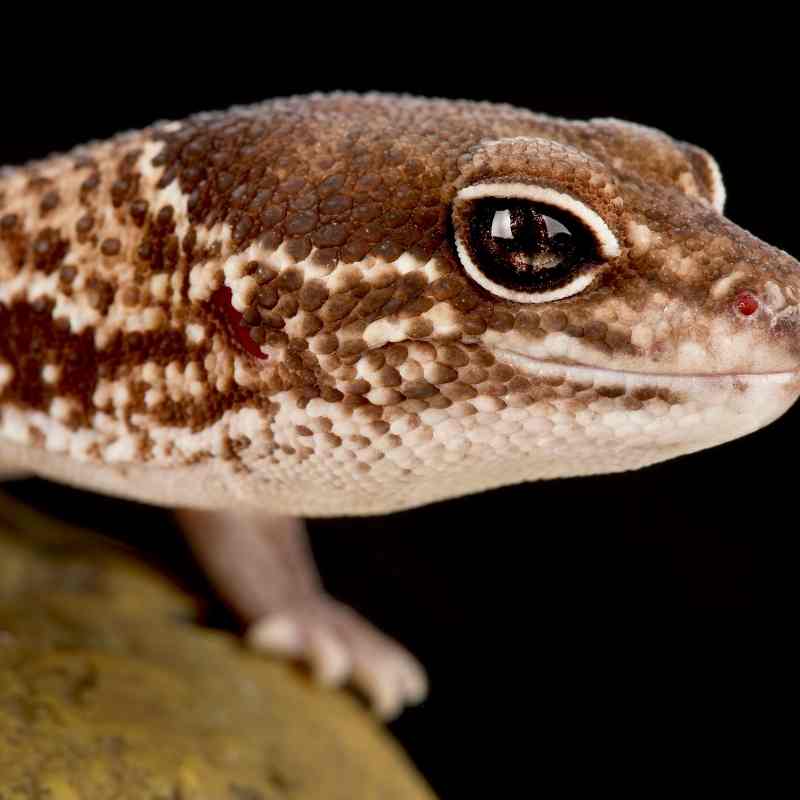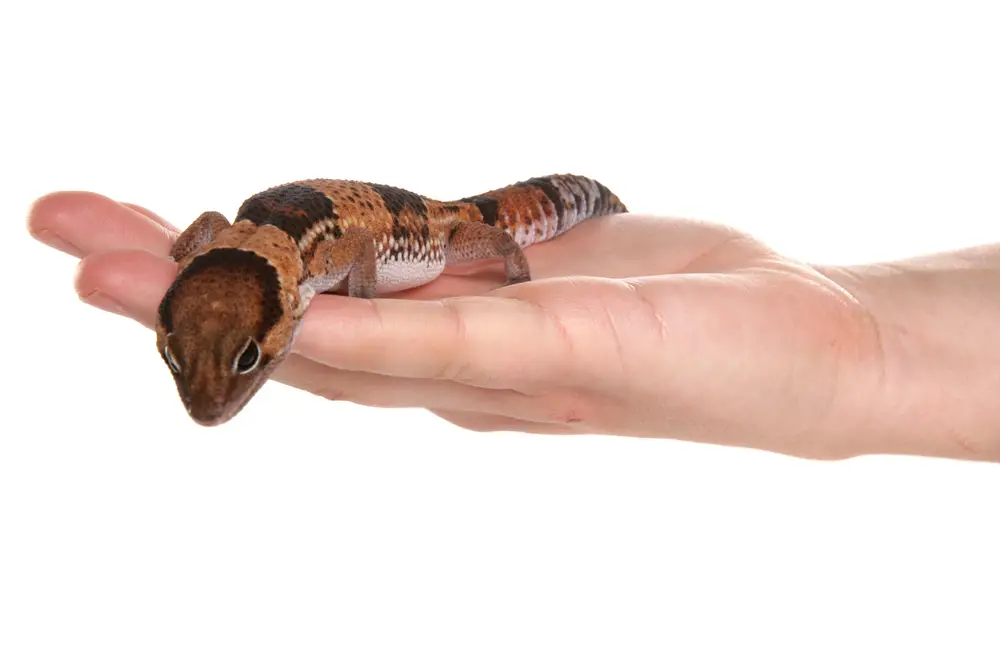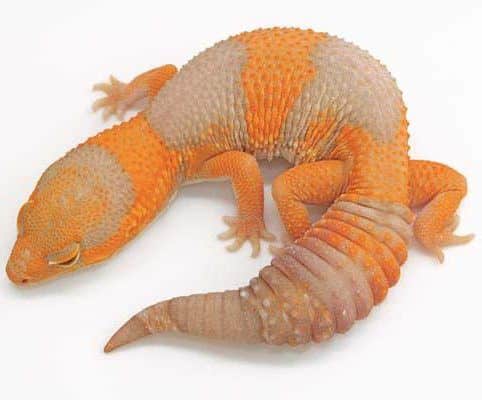African Fat-Tailed Gecko: The Ultimate Care Guide

An African fat-tailed gecko may not be as popular as the leopard gecko, but this rarity adds to its allure. The unique qualities that make this ground-dwelling gecko worth caring for include:
- Thick and bulbous, caterpillar-like tail
- Movable eyelids protecting its eyes from dust
- Calm and mellow temperament
Here is some basic information about these adorable geckos from Africa:
| Common Names: | Fat-tailed gecko |
| Scientific Name: | Hemitheconyx caudicinctus |
| Adult Size: | Seven to nine inches in length and up to 45 to 75 grams in weight |
| Lifespan: | 10 to 25 years |
| Diet: | Insects |
An African fat-tailed gecko, or AFTG, is the best pet for beginners and first-time reptile owners. Its impressive lifespan and docile temperament make it a great pet that can naturally thrive in captivity.
Contents
African Fat-Tailed Gecko in the Wild
AFTG lives in the wild West African tropical countries, inhabiting humid and dry regions. These geckos are not endangered species and thrive in their natural environment.
Their common predators include owls, small carnivorous mammals, and snakes. Sometimes, their fat tail is enough to distract predators, breaking them off so they can escape. But if they had to defend themselves, they would bite hard and stand tall with legs stiffed and tails curled up.
Check this article to learn more about how AFTG lives in the wild.
Why and How They are Unique to Other Geckos
The African fat-tail Gecko is not as common as other gecko breeds, making it a great choice for someone who wants something unique. But is there anything else that makes them unique?
The African fat-tailed gecko is not only known for its fat tail. Combining unique characteristics, personality, and habitat requirements separates it from other geckos.
The African Fat Tail gecko is unique because its tail is longer than its body’s length and thicker than other gecko species. The eyelids, personality, morphs, and habitat are also unique. They can cost more than other geckos because they are not widely available.
Some of the distinctive aspects that every AFTG has are:
- Eyelids: Most geckos don’t have eyelids. An AFTG, on the other hand, has these as a way to provide moisture and protect their eyes from their dusty natural habitat.
- Climbing: Compared to other geckos, an African fat-tailed gecko can’t stick to surfaces and climb vertically.
- Temperament: AFTG are docile and calm. They walk slowly because of the weight of their tail. However, these reptiles are still territorial despite being timid.
The Fat Tail
The most distinctive feature of the African fat-tailed gecko is its tail. It’s wide and thick and can have lines running along its length.
The fat in the tail is for storage, making it an important energy reserve. This allows them to go days without eating if there’s a food shortage.
Another semi-unique thing about African fat-tailed geckos is that they can lose their tails if attacked or threatened. The shedding of their tale can confuse the predator and allow them to escape. I say semi-unique because some other gecko species can do this, also.
The tail grows back, and it can come back rounder than before.
You can also check the gecko’s overall health by looking at its tail’s health. A rounder, fatter tail indicates it has access to a good food supply.
On the other hand, a thin tail can indicate that the gecko is not getting enough food or can be a sign of illness.
Do African Fat-Tailed Geckos Have Eye Lids, and Do They Blink?
Another unique feature of the African fat-tailed gecko is that they have eyelids and can blink. This is not typically found in other common geckos, who need to lick their eyelids to provide moisture. This is helpful for the African fat-tailed gecko, considering it comes from a dusty habitat, and the blinking eyelids can help protect its eyes from dust particles.
Do African Fat-Tailed Geckos Climb
Most geckos have sticky pads on their feet called adhesive lamellae, which help them climb upwards easily without falling, and they can even hang upside down. The African fat-tailed gecko, however, is unique because it doesn’t have these sticky toe pads. This could be because they come from a desert environment where it’s not necessary. This also means they don’t climb vertically.
Are African Fat-Tailed Geckos Active?
African fat-tail geckos dislike socializing much and love their own space. They tend to be slow, docile-natured and like to remain calm, so if that is what you’re looking for, this gecko is a great option.
Their movement is really slow, and that’s really because of their unique thick fat tails, which stop them from moving too quickly.
These pet geckos do not like being constrained, so take special care when handling them. Use open hands and never hold them by their tails. They will detach their tails as a defense mechanism, and though they will regenerate, they may have a different appearance than their original shape.
Despite African Fat-Tailed Geckos being timid creatures, they are also quite territorial. They aren’t likely to but could snap at you if you enter their space when they aren’t in the mood. If you try to hold them and they’re not happy about it, they could bite you, though this isn’t common.
The male geckos are very territorial, and it’s best not to have two male fat-tailed geckos in one enclosure as they can get aggressive and cause injuries. But a female fat-tailed gecko can be placed with a male gecko without much problem.
These unique features make them easy to handle and care for. After the initial week or so of settling in, they usually don’t mind familiar humans handling them. They will even develop individual personalities you can pick up on over time.
What is the Rarest Morph of African Fat-Tailed Gecko?
The African Fat-Tailed Gecko has many different morphs, not all rare. As breeders produce new morphs, they become more common over time. Currently, rare ones include the
- Ghost Oreo
- White Out Orio Patternless
- Super White Out
- Ghost Patternless
- Amelanistic Snow
- Amelanistic Oreo
However, breeders could still produce an even rarer one as they constantly experiment with different colorations.
Do African Fat-Tailed Geckos Make a Good Pet?
African fat-tailed geckos make good pets because of their calm temperament and longevity. They are shy and do not require constant attention. As such, it’s a good choice for those who only start with their first reptile.
Buying a Happy and Healthy AFTG
Now that you’ve committed to having an AFTG as a pet, it’s time to discover how it checks if the gecko you’re buying is both happy and healthy.
Consider the following factors when buying this type of gecko:
- Age: While you can buy an AFTG at any age, buying those between three to four months is always best. This ensures that the gecko is not wild but bred in captivity.
- Level of activity: While they are naturally docile, it doesn’t mean they are lethargic. A healthy AFTG moves around its habitat between dusk and dawn and is always interested in food.
- Healthy skin: They should not have any chronic shedding issues.
Should You Buy from a Breeder or Online Store
Understanding the differences between buying from breeders or online stores will help ensure you get the kind of AFTG you prefer.
You can meet the breeder and gecko in person if you purchase directly from a breeder. Plus, you can check the habitat conditions the geckos are living in. However, geckos – especially those from prominent breeders – are more costly.
An online store is the better choice because it has a broader selection of morphs. You can have your pet delivered the next day without leaving your home.
List of Morphs They Come In
An AFTG’s colors and patterns often dictate the amount you’ll have to shell out – the more difficult it is to reproduce a morph, the higher its price.
Here are some of the morphs you can choose from:
- Patternless
- Caramel Albino
- Banded African
- Ghost African
- Oreo African
You can find a more detailed list and pictures in this article.
How to Choose Between AFTG or Leopard Gecko
Choosing between these two gecko species all boils down to your preferences and how much you’re willing to care for them. For instance, housing them requires different humidity levels, with AFTG needing them all the time. An AFTG is also more territorial than a Leopard gecko despite being shy.
How to Transport Your Gecko
Your African fat-tailed gecko requires more attention when transporting since it’s not in its natural habitat. To ensure smooth travel for your pet, here are a couple of tips to follow:
- Use a small container with enough room for your gecko to move about but not too large that it gets tossed around.
- Keep your gecko warm during transit, as it can die from cold shock.
Read this post for a more comprehensive list of what to do and avoid for your AFTG during transport.
How to Set Up an AFTG tank
Set up the AFTG’s tank correctly if you want it to live long. While they live for up to 15 years on average, you can extend it to 25 years if you care for them well.
First, you’ll need a vivarium made of wood with a screen instead of glass. A wood vivarium regulates heat efficiently and maintains a warm environment for your pet. A 20-gallon vivarium is best as the space will allow your gecko plenty of room to move about.
Decorating the tank is a matter of matching the natural habitat of your AFTG. You can put plants like pothos and creeping figs, wood for clambering over, and caves like bamboo hollows for hiding.
Be sure to read this article for an in-depth guide on how to set up your African fat-tailed gecko’s home.
How to Clean Tank
In a nutshell, you’ll need to follow these steps to give your gecko’s tank a deep clean:
- Wear your gloves and move your gecko to another container.
- Remove everything from the tank.
- Perform initial cleaning by using warm soapy water and rinse thoroughly.
- Dry the tank completely using paper towels.
- Disinfect the tank and leave it for around 30 minutes before rinsing.
- Rinse and dry thoroughly, then wash your hands.
These steps should give you a quick overview of what you need to do when cleaning your pet’s tank. Check out our guide on Cleaning An African Fat-Tailed Gecko’s Tank Explained for a more detailed information.
Fat-Tailed Gecko Habitat Environment
The Fat-Tailed Gecko is native to hot, humid climates, so it’s critical to recreating their natural environment as closely as possible in the household vivarium.
It is usually recommended to get a 10-gallon vivarium, but 20 gallons is ideal because it gives the gecko more room to explore.
The dirt is their preferred substrate since it holds moisture without becoming wet and allows for the natural burrowing activity geckos do.
They love to spend much of their time in a humid hiding place. African fat-tailed geckos need a basking area between 86-88° degrees Fahrenheit (32° C), and their enclosure needs a humidity range of 70%-80%.
When cared for properly, they can live up to 25 years in captivity!
How to Feed Your AFTG
A common misconception about AFTG is that they eat fresh fruits and veggies because other geckos have this diet. But it’s not the case for AFTG since they are carnivorous animals.
You should only feed them with live insects such as crickets. They also need a healthy amount of vitamin D3 and calcium powder, which you can place on a shallow dish.
Regardless of what type of insect you give or your gecko’s age, you must always remember to make fresh water available in a shallow dish. Also, ensure that the tank is always clean.
What to do if they are too fat
Before placing your AFTG on a diet, determine if your gecko is fat. Unlike humans, they can’t go on a crash diet as their bodies can’t handle sudden changes.
To help your AFTG get back in shape, you should limit the volume of food and only give what it naturally eats in the wild – live insects and worms.
What to do if they are too thin
There are various ways to address an underweight gecko, and one of the common causes of this is stress. Stressors that can affect your gecko’s appetite include:
- A new or uncomfortable living condition
- Too much handling
- Bullying from other geckos in the same tank
Fixing this is a matter of removing the cause of the stress.
How to Create a Good Bond with Them and Get Them to Trust You
Bonding with your African fat-tailed gecko includes providing a proper habitat, correct handling, and healthy food. The most obvious sign you’ve established that special bond is when your gecko starts to enjoy getting held by you most of the time.
How to Handle Them and Do They Need Attention
Compared to common pets such as dogs and other mammals, your African fat-tailed gecko does not require much attention. However, once you’ve gained your gecko’s trust, you’ll find they love socializing with you.
Avoid squeezing your gecko, no matter how cute they are, and never grab them by the tail. The rule of thumb is that as long as you handle your AFTG gently, it won’t see you as a threat and will not hurt you.
What To Do If You Get Bitten
African fat-tailed geckos don’t bite unless they feel threatened or mistake your hands for food when you’re feeding them. Don’t panic even if you get bitten since they are not poisonous. You’ll need to clean the wound immediately with antibacterial soap and cover it to prevent infection.
Learn more about why AFTG bites in this article.
How to Know If They are Happy
There are numerous ways to check if your AFTG is happy. Remember that a healthy gecko is always a happy one. An excellent living habitat with the right temperature and plenty of space to move around ensures them a comfortable life. If your AFTG gobbles up its food quickly and has wide-open, alert eyes at night, it’s a happy gecko.
How to Make Sure They Are and Stay Healthy
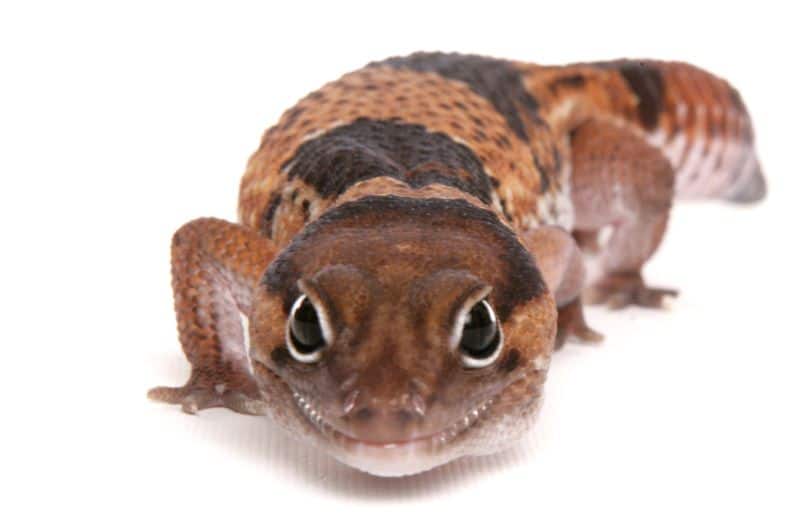
Your gecko shows several tell-tale signs of whether they are healthy or not. Skin shedding, poop quality, and even their tails can help you determine if it’s in top condition.
All About Shedding Skin
An AFTG shedding its skin is a natural process that indicates growing and healthy. Your gecko won’t need your help in this process, as it can complete the entire shedding in 30 -60 minutes.
All About Their Poop
An AFTG’s poop tells so much about their health. An ideal poop looks similar to bird droppings – it’s colored dark brown and well-formed. However, their poop can look different sometimes when they eat the substrate in their tank.
But if your gecko gets diarrhea, you must visit the vet immediately. For a complete guide about their poop, be sure to check this article.
All About Tail Loss and Tail-related Information
Every AFTG can detach its tail which is entirely natural for them. However, if your AFTG does this, you must check what caused it. In the wild, these geckos use it as a defensive mechanism. But since they’re living in captivity, there shouldn’t be any other predators in the tank.
Our extensive article on Common Questions About Your African Fat Tail Geckos Tail can help you further understand this topic.
Some Sicknesses
AFTG can occasionally experience health problems even if an expert gecko keeper takes care of them. Fortunately, the most common health issues are easy to recognize.
Mouth Rot
Mouth rot is a bacterial infection affecting most reptiles, which means a compromised immune system. When an AFTG has mouth rot, you’ll see cuts in the mouth or gums. Food stuck between their teeth is also an indication of this disease.
Stick Tail
A stick tail disease is easily determined as the AFTG’s tail looks thinner. The tail stores a lot of fat, giving an AFTG its distinctive tail appearance. If your pet is sick, it will consume this fat to help compensate for the health condition. The issue can range from a poor diet to bacterial infection. It’s always best to take your AFTG to the vet if you observe signs of a thinner tail.
Common Questions About Taking your AFTG to the Vet
Annual checkups are essential to maintain your gecko’s well-being. Aside from ensuring your pet’s health, these visits will help identify potential illnesses that might be developing. Not all vets are experts in treating reptiles, so you’ll have to spend some time researching.
Some of the common questions include “Is my gecko healthy?” or “Am I feeding my pet correctly?” For more information about what you should be asking your vet, check this post about Common Questions About Vet Visits for your African fat-tailed gecko.
Common African Fat-Tailed Gecko Behaviors
Taking care of your gecko requires considerable knowledge about its behavior. Here are some of AFTG’s usual demeanor:
Why Do they Lick
When your AFTG licks you, it’s a clear intent to get to know you more. It’s one of your pet’s ways of showing affection to you. However, excessive licking could mean an underlying issue.
Why Do they Dig
An AFTG digging can mean several things, but this behavior is natural. Your pet could be building a hole to sleep in or finding a way to cool its temperature down. Sometimes, though, your pet will dig due to boredom.
Why are they Staring
If you see your AFTG staring at you, it means it’s trying to communicate. It can either be curious about you or asking for food. Intense staring could also happen if you recently brought your new gecko home, which will eventually subside as you bond.
Rubbing Against Things
When an AFTG rubs itself against things in the tank, it could either be marking its territory or about to start its shedding process. This behavior is normal, even if your pet does this excessively.
All About Breeding the African Fat-Tailed Gecko
Breeding your AFTG has several benefits, which can help decrease the need to capture these geckos from the wild. Here are the four factors you need to consider if you decide to do this:
- Breeding time
- Cooling period
- Introducing the partners
- Caring for the eggs
Read All About Breeding the African Fat-tailed Gecko for a more in-depth guide on breeding AFTG.
Common Cohabitation Questions
You can certainly have more than one AFTG living together. But you need to know about the essential rules of cohabitation first. A male AFTG is highly territorial and requires its own tank because it can’t cohabitate with the same gender. On the other hand, two or more female African fat-tailed geckos can live together in the same tank.
How to Care for Eggs
An AFTG female can lay up to five clutches of eggs during the annual breeding period. Each clutch can have one to two eggs, depending on the gecko’s size and its health.
Once the eggs hatch, you need to help your pet care for its eggs by checking for dents and making the habitat comfortable for the mother.
African Fat-Tailed Gecko vs Leopard Gecko
Geckos are great pets, but that doesn’t mean each species is the same. Even the Leopard gecko and African fat-tailed gecko, which look very similar, have subtle differences that set them apart.
For instance, the AFTG’s tail is broader than a Leopard gecko. AFTG is also shorter and weighs lighter. Regarding personality, they belong to opposite ends of the spectrum. AFTG is calmer and timid, while a Leopard gecko is active and curious.
You’ll discover the more exciting differences between the two in this article.
Frequently Asked Questions about African Fat-Tailed Geckos
Most owners of AFTG ask the following common questions: You can find the answers at my FAQ page here.
No, African fat-tailed geckos are highly territorial, and the males will even defend their territory to death. Females are also territorial, so keeping one gecko per tank is best. They are unsociable and can inflict nasty injuries on each other.
The only time African fat-Tailed Geckos get together is for mating. The mother lays her eggs and leaves the nest, and the young are self-sufficient from the moment they hatch. Sometimes you can keep a couple of females together if the enclosure is large enough and each has its hiding spot, but there’s always the risk of an argument.
You can try keeping a male and female together, but the male can severely injure her. Just because they are of the opposite sex doesn’t mean they will always get along. Males and females can also fight except in mating season.
No, African Fat-Tailed Geckos are not poisonous.
Their skin color can change when they are about to shed their skin. The old skin turns a milky white just before shedding. Their hues may also vary somewhat as they mature, but not drastically.
African Fat-Tailed Geckos reach their full size in less than a year – around eight to eleven months after hatching. Males usually grow larger than females. Their adult size ranges between seven and nine inches in length.
They are slightly smaller than a leopard gecko. Their distinguishing features are their fat tail and their eyelids. Other geckos don’t have eyelids and clean their eyes with their tongue, while the African Fat-Tailed Gecko blinks to clean its eyes.
No, African fat-tailed geckos do not climb like other geckos. These geckoes lack the sticky pads on their toes that other geckos have and can’t climb up sheer surfaces. They are terrestrial, live on the ground, not in trees, and are not adapted for vertical climbing.
AFTGs can climb onto rocks and logs placed in their tank. They spend their time in burrows and holes in the ground during the day. The terrarium for an African Fat-Tailed Gecko should be wider than it is tall because they roam around at ground level at night.
African Fat-Tailed Geckos are terrestrial, not aquatic animals, so they are not built for swimming. They live exclusively on land and do not swim. Their heavy fat tails aren’t streamlined and would probably weigh them down in the water, causing them to drown.
Their water bowl should be shallow enough to stand in without the water over their heads. Much of their water is derived from their food, but they need humidity above fifty percent, so a water dish and misting are necessary. Occasionally, when it’s time to shed their skin, they may take a bath.
Yes, African fat-Tailed Geckos can see very well in the dark since this is when they come out of hiding. Although they are nocturnal, they need between ten and twelve hours of mild UVB light daily in captivity. The UVB light should be at the warmer end of the tank, close to the basking lamp.
However, they don’t bask full-time, so a bulb of between two and seven percent would be sufficient.
A basking light should be installed at one end of the enclosure to allow the temperature in that spot to reach between ninety and ninety-five degrees Fahrenheit in the day. You should always turn the lights off at night as they have excellent night vision.
Most reptiles don’t have liquid pee, and neither do African Fat-Tailed Geckos. Their ‘pee’ is a softish chalky white substance called urates, often excreted with their poop. Baby geckos poop several times daily because they eat small frequent meals, but for adults, it depends on how often they are fed.
If they eat every day, they will poop every day, but if they only eat once every two days, they may only poop once every two days. However, these geckos can go for a week without pooping, depending on the conditions in which they are kept. The poop looks like small dark brown pellets.
Adult geckos may not eat every day because they have extra fat in their tails. However, if they go too long without pooping, their gut could be impacted, which is a problem. You need to spot-clean the tank every day to remove excreta.
